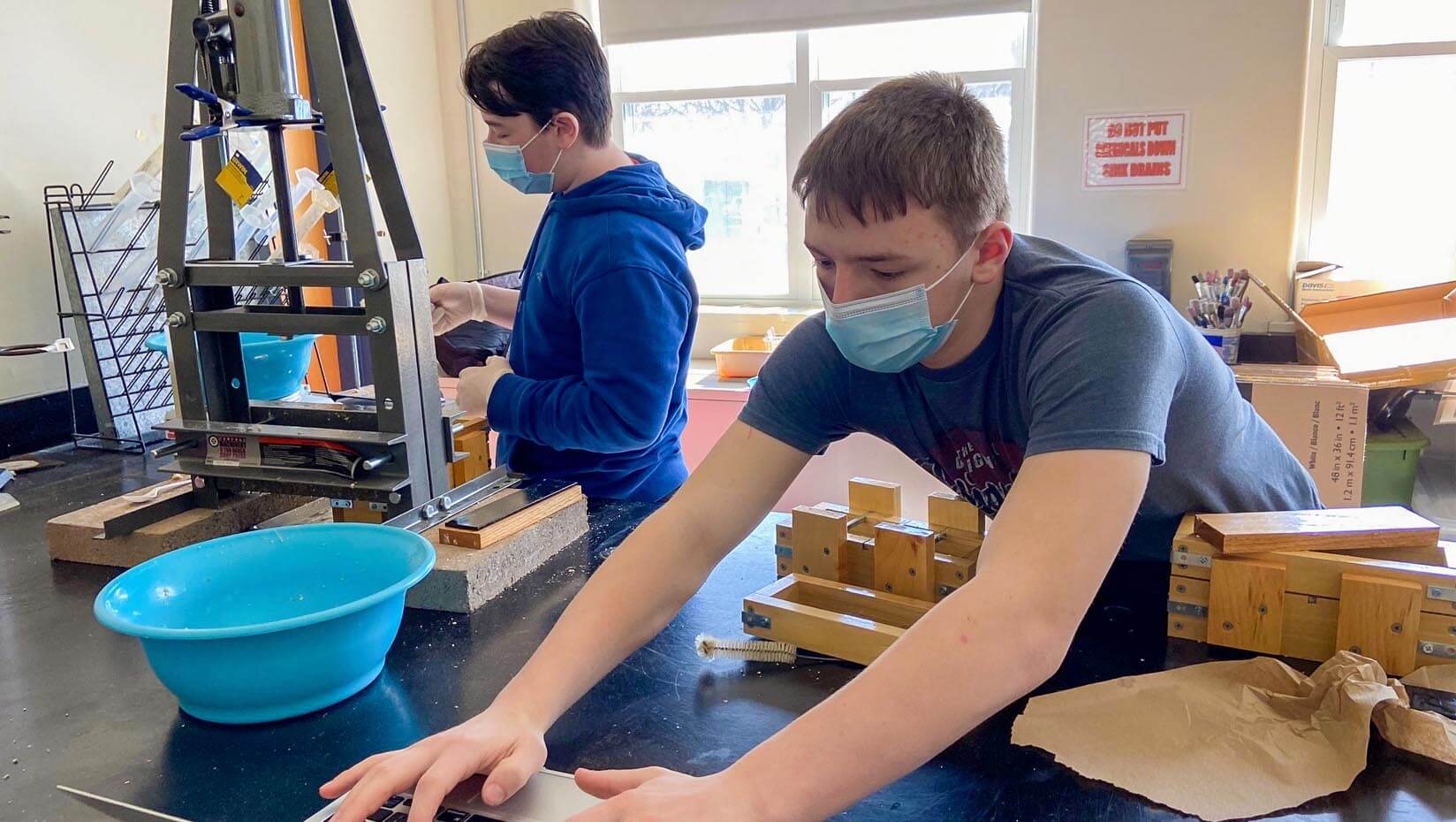
Ongoing research collaboration brings forest bioproducts to Bangor middle schoolers
This year, when eighth graders Ian Blackwell and Nik Horton were looking for a project for the Maine State Middle School Science & Engineering Fair, they spotted a spiffy varnished wood box tricked out with bracing and hardware in their science classroom at the James F. Doughty School in Bangor, and asked their teacher what it was for.
The box was a custom-made mold designed by University of Maine professor of chemical and biomedical engineering David Neivandt to shape planks of nontoxic particle board made from sawdust and bound with cellulose nanofibers. It is part of a physical science inquiry module that the students’ teacher, Tracy Vassiliev, had developed with Neivandt and others at UMaine through a K–12 research collaboration with the Forest Bioproducts Research Institute.
The module is based on recently patented UMaine technology for a particle board replacement that eliminates formaldehyde, which is classified as a known human carcinogen and can cause respiratory irritation through off-gassing. Off-gassing is cited by the EPA as the primary method by which people are exposed to formaldehyde, and pressed-wood products represent a common source of off-gassed formaldehyde in homes.
“While particle board is sort of an abstract concept for students their age, I told them about how people were getting sick from the formaldehyde that was leaching from particle board in the FEMA trailers used as housing after Hurricane Katrina,” Vassiliev remembers. “That was a real-life connection for them, and they got excited about taking on this project for the fair.”
“We saw that nanocellulose was being used for a lot of different things, and we looked up how it could be used as a binding agent,” says Horton. “We’d rather use something from nature than a bunch of chemicals.”
With physical distancing and students shifting between remote and in-person schooling due to COVID-19, hands-on labs have been a challenge this year, and Vassiliev hasn’t even been able to teach the module to her full class yet. No matter. Her students dove into making planks (each about 21 centimeters long by 6.4 centimeters wide and 0.5 centimeters high) with different ratios of cellulose nanofibers to sawdust, and then testing their strength using weight.
For the fair, students come up with their own research projects, conduct experiments, and write up and present their findings. In 2021, the fair was virtual, and Blackwell and Horton submitted a quad chart summarizing their findings, namely that the ratio of 20% cellulose nanofibers to 80% sawdust produced the strongest board “by a lot,” says Blackwell.
Their innovative project approach paid off — the boys won the $100 Lemelson Early Inventor Prize.
“It was cool that all our work actually did something,” says Blackwell. “It felt different and new.”
For Vassiliev, that’s the whole idea behind a longtime relationship with researchers at UMaine’s FBRI through the National Science Foundation’s Research Experiences for Teachers (RET) program.
Vassiliev’s first RET experience came at UMaine in 2004, related to sensors, and almost annually since 2007 she’s participated in the FBRI’s RET program, developing roughly a dozen different curriculum modules around forest bioproducts that she takes back to her Bangor classroom. RET is designed to facilitate professional development for K–12 science teachers through summer research experiences, a companion program to NSF’s Research Experiences for Undergraduates (REU).
FBRI’s RET model, built around middle school curriculum development, is unique. Vassiliev, fellow Doughty science teacher Patricia Bernhardt (now retired), Neivandt, and UMaine professor of forest operations, bioproducts and bioenergy Douglas Gardner, have collaborated on numerous publications and presentations about their work together and the benefits RET can offer K–12 educators and their students.
“I love research and I love data,” says Vassiliev, who has an M.S. in marine bio-resources and a B.S. in biology from UMaine. “[RET] helps me stay connected and keeps my bench chemistry skills intact, plus, being involved in research being done at UMaine, I have bigger ideas to grab from to help students with their science. I can push them beyond those typical science fair-type projects. My students think of me as a scientist — they’ll ask me what research I did over the summer, and I’m able to talk about all the experiences I’ve had. It’s a great way for me to model being scientifically curious and promote lifelong learning.”
“This program shows how university research can be shared and made accessible to the wider community,” says Neivandt. “Using sustainable forest bioproducts to help students learn STEM principles puts a basic science lesson in local context and directly involves them in the groundbreaking research going on right here in Maine.”
Contact: Ashley Forbes, ashley.forbes@maine.edu, 207.581.1429
